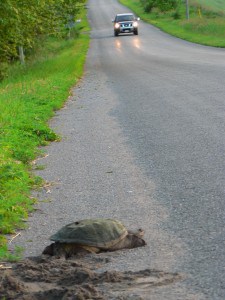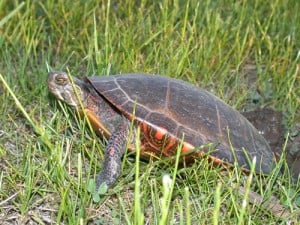All eight species of Ontario turtles are now designated as at risk
With the arrival of June, turtles are once again on the move. Unfortunately, this migration often involves a hazardous trek across busy roads and highways. Clearly, a turtle’s shell is no match for the crushing weight of a motor vehicle. The result is that thousands of turtles are killed or injured by cars and trucks in the Kawarthas each spring and summer. The carnage is devastating for turtle populations, since egg-bearing adult females are usually the victims. On the bright side, an increasing number of people are now aware of the potential presence of turtles on the road and are adjusting their driving accordingly. It is not hard to avoid striking a turtle if you are driving at a reasonable speed and scan the road ahead.
Starting in late May, turtles begin searching out a place to lay their eggs, preferably with well-drained, loose, sandy soil or fine gravel. This helps to explain the popularity of road shoulders as nesting sites. The female scrapes out a hollow with her hind legs before proceeding to deposit the eggs. Painted Turtles lay five to ten white eggs, elliptical in shape and about two centimetres long. Snapping Turtles may lay as many as 70 eggs! They look remarkably like ping-pong balls but are much smaller. When the turtle has finished laying, she uses her hind legs to fill in the hole and press down the earth around the eggs. She then drags her shell over the nest and sweeps the area with her hind feet as if to cover up any sign of her presence.
Peterborough County is home to six species of turtles, although only three, the Painted, Snapping and Blanding’s are commonly seen. Seven of Ontario’s turtle species have been classified by the Ministry of Natural Resources and Forests as species at risk. The situation for Spotted Turtles is so critical that they are now listed as endangered, meaning they face imminent extinction or extirpation. Both the Blanding’s and Eastern Musk turtles are classified as threatened. The Snapping Turtle, along with the Northern Map Turtle, are designated as species of special concern. Just last month, the Committee on the Status of Endangered Wildlife in Canada (COSEWIC) also designated the Midland Painted Turtle as a species of special concern. This means that all of Ontario’s turtles are now at risk of disappearing from the province.
Turtle populations are in decline for a number of reasons. First of all, turtle eggs stand a very poor chance of surviving the long incubation period. Predators such as Raccoons and Striped Skunks usually discover the nests within the first 48 hours after egg-laying, dig up the eggs and enjoy a hearty meal. They leave behind a familiar sight of crinkled, white shells scattered around the nest area. Since these predators tend to flourish anywhere there is human settlement – Raccoons are probably twenty times more abundant than 50 years ago – very few turtle nests go undiscovered. You can help our beleaguered turtle populations by not feeding Raccoons and by assuring they do not get into your garbage.
As already mentioned, roadkill is also a very significant cause of turtle mortality, especially during the June nesting season. Killing pregnant females not only removes reproductive adults from the population, but it also means all their potential future offspring are lost as well. According to Dr. Ron Brooks, professor at the University of Guelph, even a loss of 1 to 2% of adults annually from the “extra” mortality of roadkill will eventually lead to the disappearance of local populations.
So, what can drivers do to protect turtles? It’s mostly a matter of slowing down and watching the road carefully at this time of year, especially when travelling near wetlands, lakes and rivers. If you see a turtle on the road, consider stopping and moving it to the shoulder in the direction it was heading. Don’t return the animal to the side of the road it came from, because it will simply turn around and march right back into the traffic. You must, of course, be sure that there is no danger from oncoming cars before you perform this kind of intervention.
If the turtle is small, you can simply carry it across the road. If you are dealing with a Snapping Turtle (which can bite) the safest technique is to push and prod the animal along with a stout stick or shovel. You can also lift or pull the turtle, holding onto the rear of the shell. A Snapper can reach its midpoint so do not pick it up near the middle of the shell. Nor should you ever pick up a turtle by the tail, since this may damage its spine. It is also important not to straddle a Snapping Turtle with your car. Snappers jump up when they feel threatened, thereby hitting the undercarriage of the vehicle as it passes over them. This results in serious head trauma and shearing injuries to the carapace.
As for nesting turtles, you should never dig up a turtle nest in order to protect the eggs. You may damage them and it is also illegal. However, if you find a nest that has been disturbed by a predator, carefully place the eggs back in the hole and bury them, or bring the eggs to the Ontario Turtle Conservation Centre (see below) to be incubated. Record the location of the nest as precisely as possible and be careful to keep the eggs right side up during transport. You can also help to protect new nests by lightly sweeping the surface of the nests (to disperse the scent) or temporarily covering the nest with a board for the first few days. If you have a turtle that is nesting on your property, keep an eye out for hatchlings from late August until snow and then again in spring the next year.
Since June 2002, the Ontario Turtle Conservation Centre (OTTC) has been saving injured native turtles and releasing them back to where they were initially found. Because so few turtles ever reach sexual maturity – females don’t reproduce until they are 18 years of age – each adult turtle is part of an extremely important group. This is why it is essential to rehabilitate turtles – especially females – that have been injured as a result of run-ins with vehicles. As long as they can avoid human-related threats, turtles can live and breed for decades and thereby perpetuate the species.
If you have found an injured turtle, call the OTCC at 705-741-5000. Do not email because an injured animal needs medical attention as soon as possible. Remember to note the location (road, major intersections and/or distance from a given landmark) where the turtle was found. This is necessary in order to ensure that the turtle can be released back into the wild according to provincial regulations. Carefully place the injured animal in a well-ventilated container – plastic, if possible – with a secure lid. Do not transport turtles in water and do not offer the turtle anything to eat. Be sure to visit the OTTC website at ontarioturtle.ca or drop in at the Centre itself. It is located at 4-1434 Chemong Road, just north of Peterborough.
Nearly all of Ontario’s amphibians and reptiles – snakes included – are in a steep decline. In order to monitor changes in the ranges of these animals and fluctuations in their population numbers, volunteers are needed to submit their observations. Take note of the date and location and report your sighting to the Ontario Reptile and Amphibian Atlas. Observations can be submitted via an online form at ontarionature.org/programs/citizen-science/reptile-amphibian-atlas/ Most importantly, be sure to vote next Thursday for a political party that take species conservation and climate change seriously. This means providing greater habitat protection and assuring adequate funding for the Ministry of Natural Resources and Forestry. The future of the natural world is in a race against the clock.

